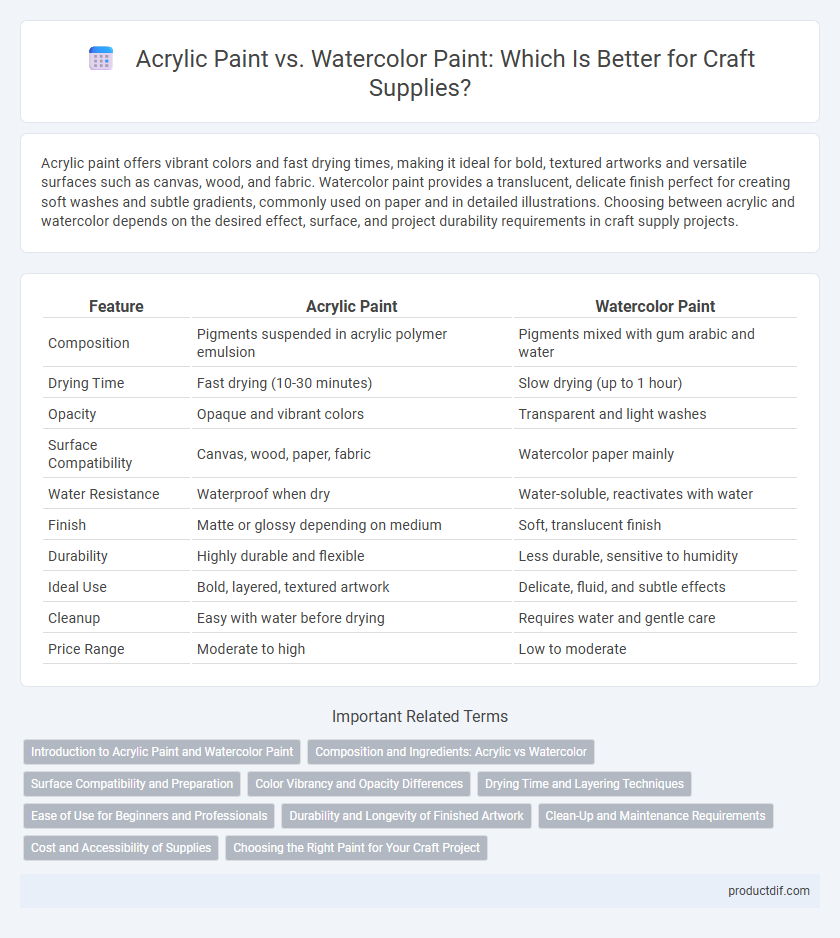Acrylic paint offers vibrant colors and fast drying times, making it ideal for bold, textured artworks and versatile surfaces such as canvas, wood, and fabric. Watercolor paint provides a translucent, delicate finish perfect for creating soft washes and subtle gradients, commonly used on paper and in detailed illustrations. Choosing between acrylic and watercolor depends on the desired effect, surface, and project durability requirements in craft supply projects.
Table of Comparison
| Feature | Acrylic Paint | Watercolor Paint |
|---|---|---|
| Composition | Pigments suspended in acrylic polymer emulsion | Pigments mixed with gum arabic and water |
| Drying Time | Fast drying (10-30 minutes) | Slow drying (up to 1 hour) |
| Opacity | Opaque and vibrant colors | Transparent and light washes |
| Surface Compatibility | Canvas, wood, paper, fabric | Watercolor paper mainly |
| Water Resistance | Waterproof when dry | Water-soluble, reactivates with water |
| Finish | Matte or glossy depending on medium | Soft, translucent finish |
| Durability | Highly durable and flexible | Less durable, sensitive to humidity |
| Ideal Use | Bold, layered, textured artwork | Delicate, fluid, and subtle effects |
| Cleanup | Easy with water before drying | Requires water and gentle care |
| Price Range | Moderate to high | Low to moderate |
Introduction to Acrylic Paint and Watercolor Paint
Acrylic paint is a fast-drying medium made from pigment suspended in acrylic polymer emulsion, known for its versatility and vibrant colors suitable for various surfaces. Watercolor paint consists of pigments mixed with a water-soluble binder, offering translucent and fluid effects ideal for paper and delicate washes. Both mediums cater to different artistic techniques, with acrylics providing durability and opacity while watercolors emphasize luminosity and subtle gradients.
Composition and Ingredients: Acrylic vs Watercolor
Acrylic paint is composed of pigment suspended in an acrylic polymer emulsion, providing a fast-drying, water-resistant finish that is durable and flexible when dry. Watercolor paint consists of pigments bound with a water-soluble gum arabic, allowing for translucent washes and reactivation with water after drying. The binder differences directly influence the paints' handling properties, drying times, and effects on various surfaces.
Surface Compatibility and Preparation
Acrylic paint adheres well to a variety of surfaces including canvas, wood, metal, and plastic, requiring minimal surface preparation beyond cleaning and priming for optimal durability. Watercolor paint is best suited for absorbent, textured surfaces like watercolor paper or rough-textured mats, where the paper's sizing affects paint flow and blending. Proper surface choice is critical: acrylics benefit from primed, non-porous surfaces, while watercolors demand specifically prepared, high-quality paper to maintain vibrancy and prevent warping.
Color Vibrancy and Opacity Differences
Acrylic paint offers superior color vibrancy and opacity due to its thicker consistency and pigment concentration, making it ideal for bold, vivid artwork. Watercolor paint produces more translucent layers with a softer, more delicate appearance, relying on water dilution to control opacity and color intensity. Artists often choose acrylics for solid, opaque coverage, while watercolors excel in creating light, transparent washes.
Drying Time and Layering Techniques
Acrylic paint dries significantly faster than watercolor, typically within 15-30 minutes, allowing for quicker layering and multiple coats in a short period. Watercolor paint requires longer drying times, often 1-2 hours, as it relies on water evaporation, which affects delicate layering techniques like glazing and wet-on-wet. The fast-drying nature of acrylics supports bold, textured layers, while watercolors excel in translucent, fluid layering for subtle gradients.
Ease of Use for Beginners and Professionals
Acrylic paint offers faster drying times and greater opacity, making it ideal for beginners who prefer easy layering and quick corrections, while professionals benefit from its versatility and durability on various surfaces. Watercolor paint requires more skill in water control and transparency management, presenting a steeper learning curve for novices but allowing experienced artists to achieve delicate washes and subtle gradients. Both mediums support creativity, yet acrylics are generally more forgiving and adaptable for users at all skill levels.
Durability and Longevity of Finished Artwork
Acrylic paint offers superior durability and longevity compared to watercolor paint, as it dries into a flexible, water-resistant film that withstands fading and cracking over time. Watercolor paint, while prized for its delicate translucency, is more vulnerable to light exposure and moisture, leading to potential color fading and paper degradation. Artists seeking long-lasting finished artwork typically prefer acrylics for their resilience and archival qualities.
Clean-Up and Maintenance Requirements
Acrylic paint dries quickly and is water-resistant once dry, making cleanup easier with just soap and water before it sets, while requiring minimal tool maintenance. Watercolor paint requires gentle cleaning with water to avoid damaging delicate brushes and often demands more frequent rinsing to prevent pigment buildup. Both mediums benefit from prompt cleanup, but acrylics typically offer a more hassle-free maintenance process for craft projects.
Cost and Accessibility of Supplies
Acrylic paint generally offers more affordable options and greater accessibility than watercolor paint, with numerous brands providing budget-friendly supplies suitable for beginners and professionals alike. Watercolor paint sets tend to be pricier, partly due to the need for specialized high-quality paper and brushes, which affects the overall costs of the craft. Acrylics are widely available in craft stores, online, and in various package sizes, making them more accessible for hobbyists on a budget.
Choosing the Right Paint for Your Craft Project
Acrylic paint offers vibrant colors, fast drying time, and durability, making it ideal for craft projects requiring vivid details and long-lasting finishes. Watercolor paint provides a translucent, delicate effect suitable for paper-based crafts and projects emphasizing subtle color blending. Selecting the right paint depends on your desired texture, surface, and project longevity, with acrylic excelling on varied surfaces and watercolor best for lightweight, absorbent materials.
Acrylic Paint vs Watercolor Paint Infographic

 productdif.com
productdif.com